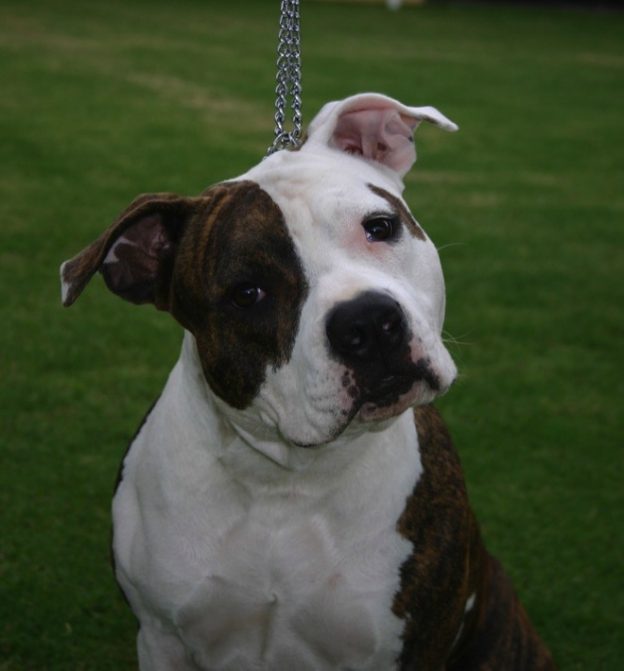
American Staffordshire Terriers are described by their owners as the perfect dogs. Their loyalty, energy and outgoing personalities are hard to resist. They’re highly intelligent, good with children, require little grooming, offer great company and will be as playful as puppies all their lives, says Melissa Greenall of the American Staffordshire Terrier Club of NSW.
“They are best suited to a family or individual willing to dedicate the time and effort required to raise a happy, healthy, well-socialised dog,” she says.
The American Staffordshire Terrier, having been selectively bred as a companion and show dog, should absolutely never appear aggressive towards people, Greenall states. “As a rule the Amstaff will thrive in a family environment. These are not dogs to be left in the backyard. They require time and attention. They definitely do best when treated as part of the family,” she says.
A well-trained Amstaff will be gentle with children, bright and alert, intensely loyal and affectionate, Greenall adds. “However, as with all dogs, their play with youngsters should be well-supervised.”
The Amstaff is a highly intelligent breed which can be very dominant if left to its own devices. It is strongly recommended that all owners undertake obedience training to ensure their new puppies grow into well-behaved, well-socialised adults.
While the Amstaff was bred for the show ring, its intelligence and athleticism see the breed excel at obedience, agility and weight-pull. Amstaffs have the ability to shine in any dog sport, which means there is no excuse not to get out there and get involved. The history of the American Staffordshire Terrier dates back to the bull and terrier mixes of the 1800s. They were general farm dogs and were fundamental to the settlement of early America.
While a number of dogs went on to be used in fighting rings across America, by the 1930s a group of fanciers petitioned the American Kennel Club to recognise what is now known as the American Staffordshire Terrier as a breed in its own right — a breed not associated with dog fighting, but a family companion and show dog. These dogs were originally called Staffordshire Terriers but by the early 1970s the breed was formally named the American Staffordshire Terrier, or ‘Amstaff’ for short.
When looking to add an Amstaff to your family, do your research. “Ensure you purchase your new puppy from a registered breeder and that your new puppy comes with ANKC pedigree papers,” Greenall urges. “With Breed Specific Legislation a real issue for all councils across Australia, it is imperative that you have ANKC pedigree papers to prove with out doubt that your puppy is an Amstaff.”
Also ensure the health of your new puppy by buying from a breeder who health tests. At a minimum the breeder should be testing for hip and elbow dysplasia, but also for heart, eyes, thyroid and patella luxation, Greenall adds. Remember, an Amstaff is a lifelong commitment and the process of bringing one of these dogs into your home should not be rushed. Do your research properly and ensure you are buying from a registered and ethical breeder. “Never buy a puppy based on colour but on correct temperament and health,” Greenall says.
The popularity of this fascinating breed promises to grow as people get wind of the gentle, loyal and courageous nature of these special dogs.
Are you prepared to do your research and wait for the right puppy from a registered breeder?
Are you prepared to dedicate the time required for training and socialisation?
Are you prepared for a physically strong dog with high intelligence?
Do you have a safe and secure yard?
An Amstaff puppy should never be purchased just because of colour but always because of health, temperament and suitability to your lifestyle. Never buy an Amstaff without pedigree papers; if it doesn’t have pedigree papers there is no way of proving it’s an Amstaff. Don’t risk the heartache of Breed Specific Legislation.
Courtesy of the American Staffordshire Terrier Club of NSW Inc.
Personality: American Staffordshire Terriers are courageous, intelligent, people-friendly, devoted and fun-loving — but these dogs will probably not back down if challenged by another dog.
Suitability: The breed is suitable for families and those wanting a good companion. Owners must be willing to train and socialise their dog.
Backyard requirements: A safe and secure backyard is a must for this breed. These dogs also need to be given at least a few hours of loving attention each day.
Original purpose: American Staffordshire Terriers have been selectively bred since the 1930s as family companion and show dogs.
Care and grooming: Owners must be committed to spending time giving their dogs companionship and exercise. Occasional bathing is required, as well as a wipe over with a grooming mitt weekly.
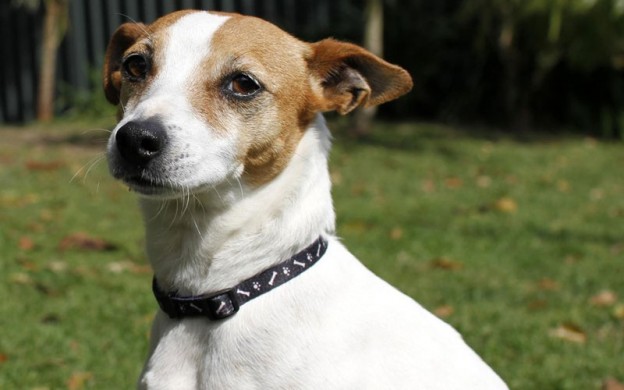
The Tenterfield Terrier was then brought to Australia by early settlers and used as a working dog to help get rid of land rats, rabbits and foxes. Today, the breed is a popular working Terrier and family companion.
The Tenterfield Terrier is extremely affectionate and loyal, a fact corroborated by breeder and enthusiast, Julie Spears. Tenties are loyal, bright intelligent and sometimes stubborn; they really want to please their people and get on well with other dogs and animals that they grow up with, Spears says. The perfect owners for this breed are retired people, young families with family members who are home most of the time, and travellers who like a pint-sized loyal companion.
These dogs get along wonderfully with children and other animals, but early socialisation is a must. As with all breeds, children should be supervised. Tenterfield Terriers are often used as companion dogs for larger breeds and can become best friends with the family cat when introduced as a puppy. They are bright, happy and friendly, and love nothing more than a cuddle in your lap.
Despite its gorgeous looks, the Tenterfield Terrier makes a good watchdog. Tenties excel as watchdogs; they are a great early warning device and will alert their family to any unusual noises or activities in their domain, Spears tells Dogs Life.
This breed loves human companionship and does not adapt well to solitary life in a backyard. A good, safe, high fence is required. Tenties are a very adaptable breed with moderate exercise requirements, Spears says. They are happy with zoomies around the yard or as your jogging partner, or are happy to just sit next to you as you relax. Tenties are suited to a small backyard, but like any dog, they do require some physical and mental stimulation.
They love to accompany you everywhere, whether it is walking, hiking, jogging or even a trip in the car. Spears also mentions the need for a secure yard and time to share, as this is a breed that thrives on human companionship. When housing the Tenterfield Terrier, you must be aware that because of its small size and single short coat, it feels the cold and needs to be housed appropriately. A warm coat in winter is a good idea.
At a [dog] show one day, I heard a shout that there was a dog on the loose, and as I turned around to see if I could help, my Patch barrelled up to me with a cheeky grin on his face. Everyone relaxed and just laughed, saying that he knew exactly where he was going. The naughty boy was determined not to be left behind and had pushed up the floor of the show trolley to get into the top deck and then pushed up the lid of the trolley to make his escape. These dogs generally do not run away, but they will run in search of you, Spears says.
The Tenterfield Terrier is extremely intelligent and responds well to training, but can be stubborn at times. Tenterfields require extra patience and persistence when it comes to training; they need to be taught basics in fun, short, 10-minute bursts, and they respond well to a positive-reinforcement method.
A Tenterfield Terriers short coat is relatively easy to look after, requiring a minimum amount of brushing. Tenterfield Terriers are a short single-coated dog we tend to call wash n wear dogs, Spears says. A quick brush once a day to remove loose hair, nails trimmed every two to three weeks, and an occasional bath is all that is generally required.
The Tenterfield Terrier is quite a healthy, robust breed and has few hereditary diseases, howe’ver luxating patellas can appear. Luxating patellas would have to be the biggest concern, but the Tenterfield Terrier Club of Australia was diligent in screening foundation stock and it is not commonly seen in our puppies. Responsible breeders would never breed from affected dogs, Spears says.
Although the lifespan of this loving breed ranges from 12 to 16 years, it is not unheard of to see Tenterfield Terriers reaching 20. If you have the time and dedication to allow one of these admirable dogs into your home, you will be blessed with an extremely loving and intelligent companion for life.
Grooming: 1 tick
Exercise: 2 ticks
Size: Small
Lifespan: 12-16 years
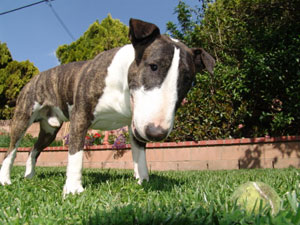
Loads of fun, with a lovely sense of humour that will have their owners in stitches.
The purebred Bull Terrier is recognised as a great dog for families with children. However, work with respected breeders to ensure you are getting a purebred.
The Mini Bull is great with families, and its size means it is often easier to handle for older or younger family members.
Both sizes like walks, but their build doesn’t make them an ideal dog for joggers. They’re more like a quarter horse, preferring to exercise in short bursts.
A strong 180cm fence for BTs and a 120cm fence for the Minis. BTs have a strong head and don’t think twice about pushing it straight through a paling fence.
One of the things that scares off would-be intruders is the look of BTs, but the BT would be more inclined to give the intruder a lick rather than a bite.
The Minis, like their bigger cousins, would sell their soul for a tasty treat, so scaring away intruders doesn’t rate as one of their strong points.
Talk to owners of either the Bull Terrier or Mini BT and they’ll be quick to recall how affectionate, loving and mischievous they are and what a real pleasure they are to own. Once this breed has made it into your home, you’d be hard pushed to find another dog to fill its shoes.
To a Bull Terrier of either size, their love of people means everyones’ lap is fair game, which can prove interesting if you’ve got a large male who thinks: I like the look of that knee. I think Ill have it.
Breed enthusiast and secretary of the NSW Bull Terrier Club, Ken Foster, first fell in love with Bullies when he saw them at a conformation show at Castle Hill, NSW, more than 20 years ago.
I saw these Bull Terriers going into the ring and screaming and throwing abuse at one another, but what really caught my eye was that while they were going hell for leather, they’d then turn around and give their owner a lick, like: Did I do right?
Ken says a purebred Bull Terrier is unlikely to bite someone and hes never heard of it happening. However, always buy your Bull Terrier from a recognised breeder to ensure your BT hasn’t been crossed with another breed.
Ken says the Bull Terrier can be a very imposing-looking dog, but they’re real sooks when it comes to people. And if properly introduced, they can live happily with other family pets.
He says they’re not a breed that will thrive in the obedience ring because they can be very stubborn. However, they are amenable to discipline and do need a sound training program to bring out the best in them.
They can be stubborn and have dominant personalities, so they need to be put in their place in the pecking order or else they can decide to run the household.
The breed was developed in England in the early 1800s for dog fighting, so its important for owners to realise they have in their care a dog which will fire up against others if provoked. While they might not start a fight, Ken says they certainly will finish it. Its important to remember that it is in their heritage its in there, he stresses.
During the past 15 years, Bull Terriers have developed a bit of a reputation with other dogs. However, Ken says breeders have fortunately recognised the problem and now breed for a sound temperament.
Even their breed standard calls for controlled aggression towards other dogs, says Ken. A reputable breeder will not tolerate a bad temperament. The BT is a real individual, and sometimes having one around can be likened to living with a muscle-bound two-year-old.
Mini in size, but not in nature. Miniature Bull Terriers offer their owners plenty of punch in a small, very manageable, but all-Terrier package.
Stalwart of the breed and the woman responsible for establishing Minis in Australia, Joy Schafer, of Windsor in New South Wales, describes them as bubbly, friendly and people-oriented dogs.
A dog that will do anything for a laugh (or a tasty treat), Minis have endeared themselves for many of the same reasons their bigger cousins are firm family favourites but also for a few reasons uniquely their own.
Joy sings the praises of her Mini companions saying they make a very good house dog because they fit into smaller spaces and don’t take up so much room on your lounge or your lap. They are well suited to older people who have owned
Bull Terriers before but want something more manageable.
But they certainly don’t represent a down-grade from their full-sized friends.
Joy says Minis mature quickly and owners don’t have a puppy for long. They grow fairly much in proportion and are designed to look just like a Bull Terrier but with a height restriction of 35.5cm at the wither. However, they are robust and strong for their size.
In the home, Minis love family life and want to be where the family action is. They love strangers and would run away with anyone who would open the fridge for them, so if you want a guard dog this is not the breed for you.
However, if you want a unique, peoples dog, guaranteed to get under your skin for a lifetime, they are perfect.
Joy says there is a subtle difference between Bull Terriers and Mini Bulls temperaments; the Minis seem to want to please you more.
The breed is used extensively for agility in the United States and they seem to thrive on the activity. Like their bigger cousins, Minis love toys, but their teeth and jaws are equally capable of demolishing seemingly indestructable products. Joy recommends not leaving toys with them to ensure they don’t accidentally swallow chewed pieces.
Make sure any balls are large enough that they can’t be swallowed. One Bull Terrier became famous for swallowing a golfball, which then proceeded to unravel inside its stomach. The dog became very sick, but it was a testimony to the BTs good physical health that it did not become seriously ill from the experience.
Joy is not a fan of rawhide chews for Bull Terriers because they easily demolish the chews and can choke on smaller pieces.
She recommends that owners choose all toys and chews very carefully and to throw them away and replace them with new ones when the toys start to get near the end of their useful life.
A bad habit the Minis occasionally develop is tail chasing. They can become obsessive tail chasers so don’t encourage them to chase their tails, which is easy for people to do because they think it is fun.
Miniature Bull Terriers originated in England in 1939 where smaller specimens of Bull Terriers were bred together to create a pint-sized version.
They first arrived on Australian shores in 1965, but because of the low numbers the breed died out. They were reintroduced in September 1986 into Victoria by Prior and Georgina Oldridge. Joy Schafer brought the dogs into Sydney the same year, and the breed has slowly but surely been re-established.
Australia’s breeding program has been so successful that enquiries for bloodstock are now received from England.
If you decide the Bull Terrier or Mini BT is for you, be prepared to convince the breeders you’re the right person to own them because most take the job of correct puppy placement very seriously.
Both breeds are hard to come by, so be prepared to wait for a puppy; but don’t worry, the wait will be well worth it.
BT breed enthusiast Ken Foster says a good owner is someone who is at home and has loads of time to spend with the breed. My first question to anyone looking for a Bull Terrier is why do they want one?
The right answer is that they’ve owned one before and they love the breed. Once you’ve owned a Bull Terrier you’ll never own another dog either the standard or the miniature.
When selecting a puppy, having a good relationship with the breeder is important. Breeders should be happy to offer ongoing support and advice, particularly if you encounter any training problems you might be too inexperienced to handle on your own.
Daily: Bullies love their tucker so make a meal of feeding time. There are various schools of thought on whats best for them but they seem to enjoy most diets supplemented with raw chicken carcasses. The occasional large thigh bone that wont splinter will keep them amused. Their short coats don’t require much work but a daily once-over with a hounds glove or rubber-backed brush will keep them spick and span.
Weekly: Bullies need a lot of human companionship, so whatever your weekly activities entail, keep them involved and they’ll reward you with loads of love.

The Wire Fox Terrier is said to have originated in the mid 19th century as a cross between the Airedale Terrier, Bull Terriers, Greyhounds and Beagles. Their distinguishing features include their narrow head and dense, wired coat. Originally bred to assist in the hunting of vermin and foxes, the Wire Fox Terrier now makes a great companion.
Personality: The lively and energetic Wire Fox Terrier is both brave and bold. They absolutely love their family and will do anything to protect them. Much like other terriers, the Wire Fox is intelligent but stubborn. Training is important from a very young age to avoid bad behaviour in the future. They like to play rough so make sure they’re treated to outdoor games and long walks. If possible, it’s a good idea to let the Wire Fox off the leash to run, however they will chase smaller dogs so be vigilant.
A great dog for: Affectionate and protective, the Wire Fox is great for families with young children with time and energy to play with the dog outdoors.
Favourite activities: Playing games, staying active, fetch, long walks, running, playing with children.
Backyard requirements: The larger the space the better for the Wire Fox Terrier. However, they can adapt to apartment living as long as they’re taken on long daily walks. A backyard is preferred.

Grooming: The Wire Fox Terrier requires a lot of grooming to look its best. Hand trimming their coat is necessary several times a year, best done by a professional. To keep the double-layered coat tangle free, the coat requires brushing a couple of times a week.
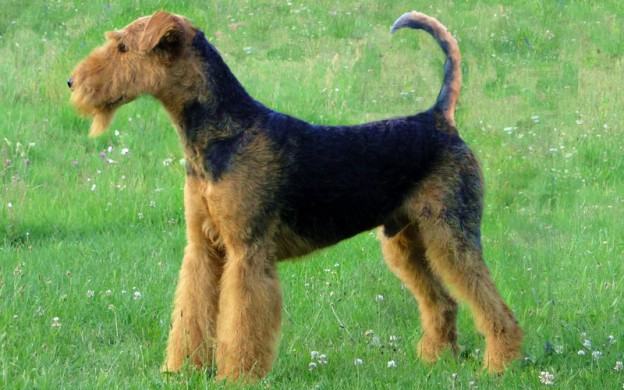
The wonderful Airedale Terrier has heads turning and hearts melting. No wonder this gorgeous breed is winning the praises of thousands across the globe. By Lauren Nethercote.
Personality: A fun-loving, loyal and very sweet breed that adores its family and will happily take all the affection it can get.
Favourite activities: Spending time with the family is top of the list for this pooch. The Airedale will also enjoy a daily outing — be it in the car or going for a walk.
Watchdog qualities: This canine makes an excellent watchdog and will bravely alert you to anyone who approaches your property.
Backyard requirements: This breed will happily exercise in a good-size yard, but will enjoy a daily walk. It needs to be included in family activities and loves spending time in the house.
Hereditary diseases: The Airedale is a hardy breed with few hereditary diseases. Things to watch out for are hip dysplasia and possible dry skin. Buying from a reputable breeder will reduce the chances of getting a pup with health problems.
Daily: Fresh water and a well-balanced diet. Enjoys a daily walk or run in a good-size backyard.
Weekly: A good weekly comb will help keep the coat free from mats.
Monthly: Regular nail trimming and ear cleaning.
Other: Gastrointestinal worming every three months for adults, more frequently for puppies, heartworming and vaccinations.
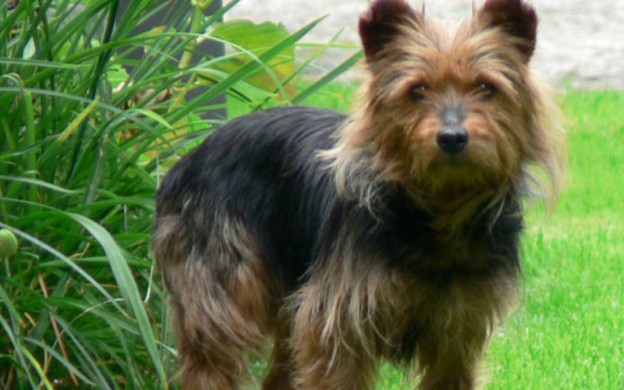
Created in the early 19th Century by the British, the Australian Terrier was bred from a number of Scottish and British terriers to hunt snakes and guard sheep. As with all terriers, the Australian is a small dog with a big personality and stubborn attitude. The breed are characterized by their short stature, lively and energetic nature and long neck and back. The Australian Terrier’s coat can be blue, tan, steel blue, dark grey blue, solid sandy, red or solid black.
Personality: The Australian Terrier is a friendly and obedient dog. The breed tend to be stubborn, much like other terriers but they are hard working and great watchdogs, always eager to please their owners. Intelligent, they can be trained from a young age but it does require patience.
A great dog for: An energetic owner who is willing to take the time to train them. The Australian Terrier makes a great family pet and is well behaved around young children.
Favourite activities: The Australian Terrier is a very energetic breed who requires a lot of exercise. They will work to keep busy but need to be given something to do. They love playing games and going on long walks.
Backyard requirements: A secured fenced backyard is necessary to stop the terrier from wandering off on an adventure. The Australian Terrier can live indoors, provided they receive enough exercise to burn off their energy.
Grooming: The Australian Terrier needs to be brushed and combed at least once a week to keep the coat healthy and minimize shedding. Baths are only needed as required and ears should be checked regularly for hair.
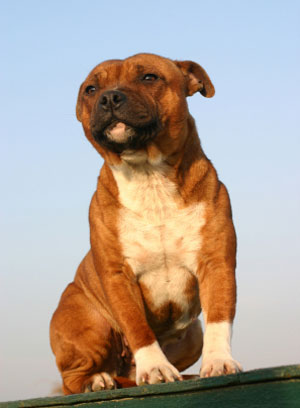
The Staffordshire Bull Terrier is a small to medium breed that is suitable for families and doesn’t need lots of grooming.
Personality: A fun, loyal pooch that will thrive with good training and socialisation, and if it is accepted as one of the family and included in family activities. The Staffy has a soft spot for kids and makes a wonderful family pet.
Suitablity: Families with children; singles looking for a close companion.
Favourite activities: Spending time with the family will be high on the favourites list for this pooch, as well as regular outings and getting involved in agility, flyball and obedience.
Backyard requirements: The Staffy does not need lots of space at home because of its small size, but without regular exercise it will become destructive.
Watchdog qualities:The Staffy can always manage to scare off a stranger simply with a snarl and a stare, but this is an inherently friendly breed and is not aggressive towards strangers. It should never be bought to serve as a guard dog or be trained for that purpose.
Hereditary diseases: The Staffy can occasionally suffer from epilepsy and cataracts and some pups may be born with soft or cleft palates. All conditions are manageable with medication or surgery.
The smiling Staffy is a wonderful dog that has proven, over the years, to be one of the most loyal, doting canine companions any family could wish for. With a big heart, a big personality and a smile so large you’d think it could swallow you up, this happy-go-lucky breed will repay a good, caring family tenfold in love and affection.
With a history dating back to the bloody dog sport rings of the 1800s, the Staffy’s nature was unfairly tainted when, in those days, it was bred for dog fighting and bear-baiting to provide entertainment for blood-thirsty audiences. However, it was often said that as soon as the dogs left the fighting ring, their aggression would disappear and they would become calm and gentle, even watching over babies in the family. With those cruel days now far behind it, the Staffy has become one of the most popular of all dog breeds and is sought after by families wanting a fun, gentle pet for adults and kids alike.
Mad about kids
The Staffy got its name from Staffordshire in England, where, in the early 1900s, miners and iron workers began breeding the dogs for companionship and showing. The Staffy arrived in Australia in the 1950s and is today one of the most even-tempered breeds available. According to the experts, the Staffy is one of the best dogs to have around kids and seems to have a natural affinity for children. Breeders recommend early training and socialisation, as with all breeds, but warn the Staffy does not respond well to harsh training methods. Gentle, positive reinforcement and lots of patience is the way to go. The Staffy is known to be a highly intelligent dog and excels at obedience, flyball and agility.
Part of the pack
While the idea of owning a Staffy may seem a good one to some, keep in mind the advice of Staffy breeders who emphasise this is an inside dog and needs to be a part of the family rather than left outside to its own devices. The Staffy craves attention and love from its family and can become problematic if left on its own. Breeders say this can lead to destructive behaviour, separation anxiety, barking and depression.
Another reason to keep your Staffy inside is its thin coat, which makes this breed susceptible to heat and cold. Some refer to the Staffy as the ‘wash-and-wear’ dog because it is so easy to look after. Although fairly dense, the coat is short and easy to brush, however it can harbour fleas and ticks in the summer months so always check carefully for those nasty critters. This pooch’s thin coat makes it susceptible to extreme weather conditions; be especially vigilant on hot days and always ensure your Staffy has plenty of shade and cool water.
Convenience plus
The Staffy is very popular with families because it is such a convenient dog in so many ways. It is a manageable size, does not come with grooming baggage and is fun for kids and adults alike. The only demand your Staffy will make of you is to get a regular outing each day. If your pooch is well socialised, off-leash parks are great fun for dogs to play with each other and get rid of pent-up energy. If your Staffy is not good around other dogs or people, make sure to give it a good walk on-leash each day. Unless your dog is well trained to stay by your side or come when called, never leave it off-leash near roads.
Buy wisely
The Staffy’s growing popularity has brought with it the unwanted consequence of backyard breeding. To ensure you buy a healthy pup with the right temperament, always deal with reputable, registered breeders who have the breed’s best interests at heart.
If you’re unsure about your ability to handle a new pup, Staffies are very adaptable so there is also the option of re-homing an older dog. This means you get an already-trained and well-behaved adult without having to worry about all the work that comes with puppies.
Big head
The Staffy’s very wide head may give us the wonderful Staffy smile, but it can cause breathing problems for this pooch at the same time. The Staffy’s wide head has made the breed susceptible to breathing problems, which may be exacerbated in hot weather. Always watch that your pooch does not start showing symptoms of heat stress in summer, and if your Staffy does appear to be struggling to breathe in the heat, wash him down in cool water.
Daily: A good daily walk is a must to keep your Staffy stimulated. Avoid exercising in the middle of the day in summer. Always ensure there is cool water available and feed an appropriate diet. In winter, make sure your pooch has enough shelter and is kept warm.
Weekly: A brush once a week will keep the coat shiny. Remember to check for ticks through summer. Monthly: Check ears and eyes and if nails need clipping. Bath once a month, if necessary.
Other: Gastrointestinal worming every three months for adults, more frequently for puppies, heartworming and vaccinations.
Read about the breed
Books
Websites
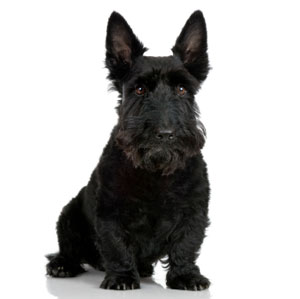
Care and exercise
The Scotties coat, if left ungroomed, will result in the dog looking like a well-used doormat on legs. It is a particularly hard, harsh jacket which needs a couple of thorough strippings and many trimmings per year to retain the true Scottish Terrier appearance and finish. Unless you have or can obtain the necessary expertise, the major strippings are best left to a professional groomer. As to exercise, the Scottie will normally get all it needs around the house or yard, but if you take it for a walk you will probably wear out before it does.
Suitability
Scottish Terriers are hardy, adaptable small dogs suitable for any size of house or apartment and, while generally dependable with young children, are probably at their best with an adult family. Their quiet, sober habits and protective instincts make them ideal companions for older folk.
This courageous little dog is well known for gracing the screens of commercials for many brands and promotions. No wonder its such a sort-after dog all over the world.
Whisky drinkers will instantly recognise the Scottie as the black dog on the Black & White Scotch label. This may be the reason for this breeds world-wide popularity for over a hundred years. As you may just have guessed, the Scottish Terrier hails from a certain country north of England, specifically from the Aberdeen district. In fact, it was originally known as the Aberdeen Terrier, bred to hunt the various burrowing animals considered vermin by the Scottish farmers. This accounts for its sturdy, low-slung body, long, strong foreface and tough, dense, wiry coat, not to mention its courage and tenacity. Black is not its only colour the Scottie also comes in the less common wheaten and brindle coats.
Somewhat reserved, even dour, to its family the Scottie is a loyal, affectionate, cheerful but not excitable, independent little dog who makes few demands of them. It is also a very good watchdog. Weighing in around 9-10kg, the Scottish Terrier stands about 27cm at the shoulder.
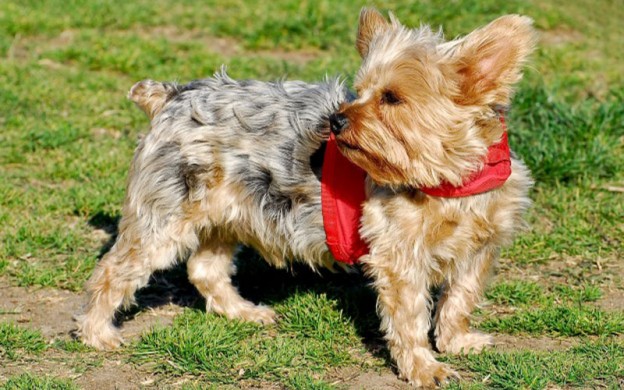
The Australian Silky Terrier is full of energy, thrives on activity and loves constant playtime.
Personality: Intelligent, assertive and loyal, the Australian Silky Terrier is a happy, playful breed. Originally bred to kill rodents, they thrive on constant activity and are always on the lookout for scurrying prey. This breed is known to maintain a puppy-like attitude throughout life.
Suitable for: Full of energy, this versatile breed will adapt to any situation, making it suitable as a companion in a one-bedroom apartment or as a family dog. It usually devotes itself to one particular family member (usually the one who feeds it). The Australian Silky Terrier is great with children and will play with them for hours. Their small size makes them ideal household pets.
Favourite activities: Thriving on activity and entertainment, the Australian Silky Terrier enjoys a good ball game, chasing a Frisbee or going for a long walk to keep happy and healthy.
Watchdog qualities: Often thinking they are bigger than they actually are, the Australian Silky Terrier is a brave and assertive little dog with strong guarding instincts.
Hereditary disease: The Australian Silky Terrier is a very hardy breed. Patella Luxation (slipping of the kneecaps), the only genetic weakness, is uncommon today but has been known to occur in the breed. When looking for an Australian Silky Terrier, ensure you go to a registered, reputable and long-term breeder and look at both parents.
Daily: If you’re looking for a low-maintenance dog, then the Australian Silky Terrier is the dog for you. Twenty minutes exercise a day is sufficient for this breed, whether it be playing ball, chasing a Frisbee or going for a good long walk. A nutritious meal, plenty of fresh water and adequate shade will also keep this breed happy and healthy.
Weekly: The Australian Silky Terriers single coat doesn’t need a lot of maintenance and they just love a good brush. Twenty minutes a week should be sufficient with light grooming focusing around the eyes, ears, muzzle and underneath the tail. A weekly bath will also ensure their coat stays in tip-top condition.
Monthly: Treatment for heartworm, ticks and fleas is essential for the Australian Silky Terrier and their nails should also be checked and clipped regularly.
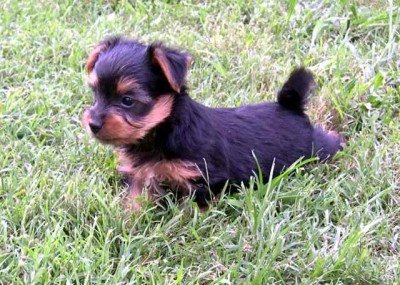
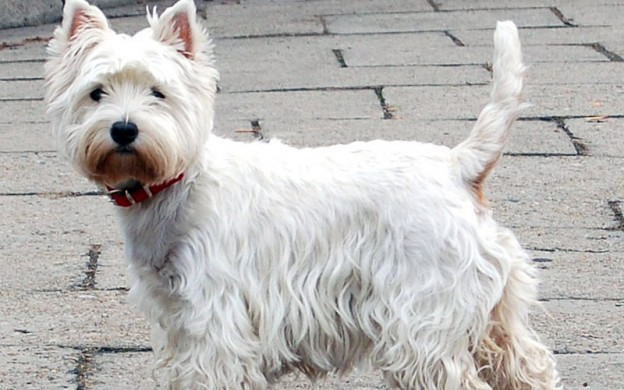
With its playful and sweet-natured personality, the beautiful Westie makes the perfect companion for individuals and families. By Helen Frost.
Personality: Most commonly described as lively and playful, the Westie is a sweet-natured breed and incredibly loyal. If your Westie wants your attention, it will do anything to get it. They are very intelligent and are fast learners, however their independent spirit can sometimes make them a challenge. Westies have tremendous courage and are outgoing, ever faithful and love human company. Being terriers, they have a hardy personality and can also be very inquisitive.
Suitability: Westies are ideal companions for any individual or for the family as a whole. They are equally at home in the suburbs or the country and love to go for walks, play ball, or simply be with their owners. They don’t need a lot of exercise but do need to be taken out and walked — sometimes you have to prompt them to come with you. Their size and stamina make them the ideal playmate for children. They are not really a one-man dog and will show affection to the whole family. This does not mean, however, that they may not show a slight preference for one particular person.
Backyard requirements: Gardens need to be well fenced as some Westies enjoy wandering o#. They are also known to dig so make sure it is a sturdy fence. A large yard isn’t necessary as long as you provide regular walks and lots of attention. Most Westies can live with an existing family pet, such as another dog or cat, although breeders recommend not having Westies with guinea pigs or rabbits.
Watchdog qualities: This breed will alert you to someone new approaching the house. Although great for signalling unwanted visitors, the barking can become more consistent if the dog is neglected and not given enough attention and affection — they really need to be included as part of your family. The Westie is alert and inquisitive and it certainly doesn’t miss a trick.
Hereditary diseases: As with most breeds, there are hereditary faults in Westies and it is the responsibility of breeders to try to eliminate these problems. Legg Perthes affects the head of the femur but is operable and usually affects Westies under 12 months of age. Craniomandibular Osteopathy (CMO) is a calcification of the joint between the lower jaw and the skull and is very rare in Australia. The main health problem to be aware of today would be skin allergies caused by a variety of factors including fleas, plants, carpets and diet.
Daily: Shade, fresh water and a wellbalanced diet are essential. Show Westies are groomed very differently and their coats are hand-stripped every day for around 15 minutes.
Weekly: Westies do not shed their hair in the normal way; they may lose a few hairs but that is all. You should brush your pet Westie regularly — daily if possible — as this prevents the coat becoming tangled and knotted. The coat does grow quite thick and long, so professional grooming every 12 to 14 weeks is suggested.
Other: You need to make sure your Westie is wormed, vaccinated and regularly checked for ticks. Vaccination is annual, monthly worming is only done if using an all-in-one product (for heartworm, intestinal worms, “leas etc), and checking for ticks should be done daily if living in a tick area.
For more information on the West Highland White Terrier or to locate a breeder, contact your state canine council via the Australian National Kennel Council and New Zealand Kennel Club.
DogsLife is proudly powered by WordPress
